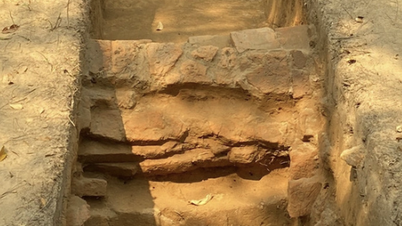At Petrified Forest National Park, in the US state of Arizona, scientists have found valuable fossils, revealing an ancient period 209 million years ago.
This was a transitional period, when many ancient species gradually disappeared to make way for the age of dinosaurs.
Most notable among them is the discovery of Eotephradactylus mcintireae - the oldest flying reptile (or pterosaur) ever found in North America.
The fossils were found in volcanic ash-rich rock, suggesting that this was once a lush tropical ecosystem on the southern edge of the vast supercontinent Pangaea.
Interestingly, despite being a contemporary of dinosaurs, there were no traces of them at this site. Instead, scientists found a unique fauna that included primitive frogs, land-dwelling turtles, and lizards that were distantly related to the tuatara that now inhabits New Zealand.
"Although dinosaurs appear in contemporaneous rocks in Arizona and New Mexico, they are completely absent from the ecosystem we are studying. This suggests that early dinosaurs had different habitat preferences," explains paleontologist Ben Kligman of the Smithsonian National Museum of Natural History, who led the study.
The new pterosaur has been named Eotephradactylus mcintireae, with "Eotephradactylus" meaning "dawn goddess with ash wings" - both a nod to the volcanic rock that encased the fossil and to the fact that it was one of the earliest known pterosaurs.
And "mcintireae" is in honor of Suzanne McIntire - an excavation expert working at the Smithsonian Institution, who directly found this specimen.
Eotephradactylus had a wingspan of about 1 meter and a skull length of 10 centimeters. They possessed a lower jaw with sharp teeth in the front to grab fish as they glided over the river, along with razor-sharp teeth in the back to tear their prey effectively. This was a cunning predator, preferring to live near water.
The fossils collected by experts include a partial jaw bone with teeth, individual teeth and long limb bones that helped form wings - a feature of pterosaurs - the first group of vertebrates in evolutionary history capable of flight.
In addition to Eotephradactylus, the Arizona fossils reveal a rich ecosystem with at least 16 species of vertebrates, including seven that are completely new to science.
A land-dwelling turtle, distantly related to modern turtles, coexisted with freshwater sharks, bony fish, and a giant fish-hunting amphibian.
Notably, the predators that dominated this land were not dinosaurs, but reptiles distantly related to crocodiles, including phytosaurs - semi-aquatic creatures with noses located on top of their heads, like today's crocodiles; and rauisuchians - terrestrial, four-legged carnivorous reptiles that could grow up to 6 meters long, even larger than the carnivorous dinosaurs of the time.
The Triassic is a period between two major mass extinction events: one 252 million years ago - the worst in Earth's history, and one 201 million years ago - which marked the end of many groups of prehistoric reptiles, paving the way for the golden age of dinosaurs in the Jurassic Period.
According to scientists, both events were linked to intense volcanic activity, causing global climate changes.
Although many of the creatures found in the Arizona fossil record have since become extinct, frogs, turtles, and pterosaurs like Eotephradactylus adapted, survived, and left descendants that live on to this day.
Another hypothesis is that they flew in the sky for millions of years until a giant meteorite ended the dinosaur era 66 million years ago./.
Source: https://www.vietnamplus.vn/my-phat-hien-loai-than-lan-bay-co-dai-nhat-bac-my-co-nien-dai-209-trieu-nam-post1048839.vnp



























![[Photo] Gia Lai provincial leaders offer flowers at Uncle Ho's Monument with the ethnic groups of the Central Highlands](https://vphoto.vietnam.vn/thumb/1200x675/vietnam/resource/IMAGE/2025/7/9/196438801da24b3cb6158d0501984818)









































































Comment (0)